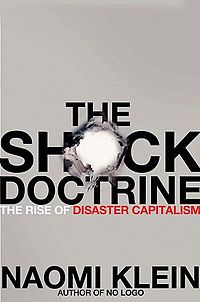Sometimes I’m late to the party, but I always bring extra Beer. Naomi Klein’s “The Shock Doctrine” has been out since 2007, and It finally came to the top of my reading list. This book, subtitled “The Rise of Disaster Capitalism”, is a stunning indictment of CIA mind control, the long series of U.S.-sponsored coups and unbridled free-market economic theories that have destroyed whole countries. The dark overlord that birthed this project is economist Milton Friedman of The University of Chicago, epicenter of the most extreme version of capitalism existing today. Friedman’s economic theories were untested in their inception, but as Klein writes “… The idea of exploiting crisis and disaster has been the modus operandi of Milton Friedman’s movement from the very beginning – this fundamentalist form of capitalism has always needed disasters to advance”. Klein continues: “The ultimate goal for the corporations at the center of the complex is to bring the model of for-profit government, which advances so rapidly in extraordinary circumstances, into the day-to-day functioning of the state – in effect, to privatize the government”. Beginning with this heading to the introduction; “Blank is Beautiful – Three Decades of Erasing and Remaking The world”, Klein explains: “Believers in the shock doctrine are convinced that only a great rupture – a flood, a war, a terrorist attack – can generate the kind of vast, clean canvases they crave”.
In The Shock Doctrine, Naomi Klein has found a perfect metaphor for what the Chicago School / Friedman cult attempted (successfully) to do to resource-rich countries. She compares the economic shock trauma to programs run by the CIA to break down an individual’s personality and re-make it into something completely different. Klein profiles CIA experiments run by psychiatrist Dr. Ewen Cameron in the 1950’s at McGill University that would be later used to torture prisoners in countries under both armed and economic attack in Latin America and later the middle east. The first step is “depatterning”, to turn the mind back to a blank slate. Klein describes it as “shock and awe warfare on the mind”. Dr. Cameron and his associates used electroshock, sensory deprivation, and intensely psychoactive drugs to “depattern” his patients, without their knowledge that they were “lab rats” for CIA brainwashing experiments. The catalogue of techniques learned in these experiments became what the CIA called “Kubark counterintelligence interrogation”, and were used all over the world – including to U.S. captured detainees in Guantanamo Bay Cuba. The techniques for repatterning an individual were also used to depattern and repattern whole populations and countries.
Milton Friedman’s Chicago School of economics is a fundamentalist economic faith based on privatization, government deregulation and deep cuts to social spending. It is described as a counter-revolution against Keynesian “New Deal” programs that prop the economy from the bottom up. It called for the breaking of The New Deal through privatization and a rejection of third-world nationalism. Corporations were simply not going to let nations run their own resource management. The CIA sponsored a series of coups – Iran in 1953, Guatemala in ’54, and the grand experiment in Chile – 1973. Beginning in 1956, students from Chile and other Latin American countries pursued advanced degrees at the University of Chicago – leading to severe free-market reform measures. When Salvador Allende won election in Chile in 1970, Chilean political parties were favoring the nationalization of the copper mines, which were under the control of U.S. mining corporations. President Nixon was so furious he ordered CIA director Richard Helms to “make the Chilean economy scream”. U.S. corporations were apoplectic and soon engineered a coup by the Chilean far-right – backed by the CIA. The pattern would soon be repeated as far away as Indonesia, but Chile was the test laboratory.
Klein identifies three forms of shock that were administered to the target countries; 1. The brutal coup itself, 2. Milton Friedman’s economic model (privatization & deregulation) and 3. Torture and repression. In Chile, 13,500 people were arrested, 3,200 were disappeared or executed, 80,000 were imprisoned and 200,000 fled the country. In Argentina another 30,000 people were “disappeared”. In Indonesia – in just one month – an estimated 1 million people were killed, according to Time Magazine. That’s how U.S. tax dollars were used to open up resources for exploitation by U.S. corporations.
The best-laid plans of Chicago School / Friedmanomics ultimately failed; by 1988 45% of the Chilean population had fallen below the poverty line. Argentina refused to pay its debt, calling it “odious debt” used to torture the population. But ultimately in the 1990’s Argentina was forced to sell off 90% of all state enterprises to private companies and fired at least 700,000 workers. And as Klein points out, Argentina’s early ‘90’s shock therapy program was written in secret by financial giants JP Morgan and Citibank.
—————————————————————
Coming in part 2, on to eastern Europe, Iraq and the world…



The world has to end some time…
😉